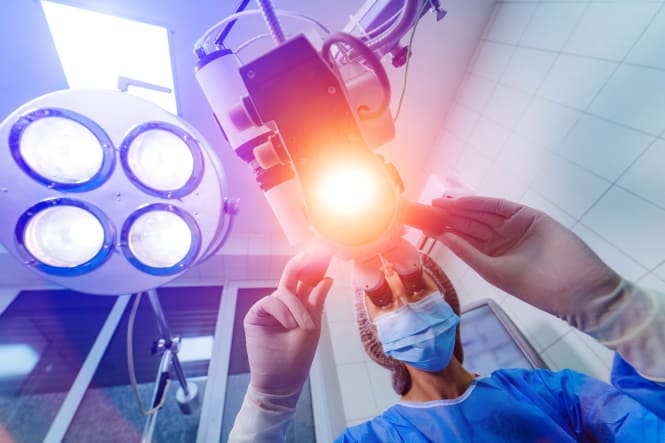Durrie Vision Helped Pioneer LASIK Surgery and Other Vision Correction Procedures
It’s impossible to outline the history of laser vision correction and refractive eye surgery without mentioning Durrie Vision in Overland Park.
In fact, our history is deeply ingrained in the timeline of the development of LASIK surgery, in particular, among other landmark vision studies and discoveries.
The First Laser Vision Correction
The earliest refractive surgeries – any surgery that improves your vision without lenses – occurred in 1948, long before lasers were put to work. Refractive surgeons relied on their steady hands and sharp, tiny scalpels to provide vision correction.
But that changed in 1988, with the introduction of the excimer laser, previously used in making microelectronic chips in the 1970s. The first time the excimer was used on eyes was during PRK, or photorefractive keratectomy, by Dr. Steven Trokel.
It took seven more years before the Food and Drug Administration (FDA) approved the new PRK procedure in 1995. Our wn founder Dr. Durrie became the first US surgeon to perform the PRK surgery following FDA approval.
The Excimer Laser Is Put To Work During LASIK Surgery
In 1991, refractive surgeons Slade and Brint performed the first LASIK procedure in the United States. This procedure also used the excimer laser to reshape the cornea and correct refractive errors. The surgeons manually created a corneal flap prior to using the laser.
In 1996, LASIK surgery gained FDA approval and has since become the most popular laser vision correction in the country. In 1999, Durrie Vision served as a clinical research site for LASIK.
The Field of Laser Vision Correction Continues to Grow
In 2003, Durrie Vision yet again served as a clinical research site for refractive lens exchange and in 2005 for Phakic Intraocular Lens (IOLs) implants.
But piloting such procedures was only the beginning for Durrie Vision, and the greatest advancement in LASIK surgery was about to happen right here in Overland Park.
Introducing the Femtosecond Laser!
Dr. Slade, the LASIK surgery pioneer, partnered with Dr. Durrie to continue improving the popular laser vision correction procedure. In 2002, they developed Sub-Bowman’s Keratomileusis (SBK) Advanced LASIK.
This procedure uses a femtosecond laser to create a corneal flap, rather than having a refractive surgeon manually use a blade. The excimer laser is then used to reshape the cornea and correct refractive errors. A safer procedure than traditional LASIK, SBK is today’s bladeless standard.
Topography-Guided LASIK
One of the newest forms of LASIK to gain FDA approval, topography-guided LASIK, treats myopia and astigmatism, customizing the laser treatment to the surface shape of the patient’s eye.
Using wavefront optimization, during the SBK Advanced LASIK procedure can help prevent glare and halos at night, common and often temporary side effects of LASIK surgery. Patients with abnormal corneal surfaces may also qualify for topography-guided LASIK if they weren’t good candidates for earlier versions of this laser vision correction procedure.
Am I A Good Candidate for Laser Vision Correction in Kansas City?
Just as precision tools became part of standard LASIK surgery protocol, so, too, are they used to determine candidacy for any laser vision correction procedure, especially when you visit Durrie Vision.
Our refractive surgeons and their team use our Advanced Ocular Analysis, a multistep examination that provides in-depth details about your vision, eye health, cornea shape, and more. This examination precludes any refractive surgery, including cataract surgery and refractive lens exchange.
If you previously were told by another eye surgeon that you aren’t a good candidate for LASIK, or if it’s been a while since you were approved, we recommend making a no-obligation, complimentary appointment for an AOA here at Durrie Vision. Our state-of-the-art tools and analysis methods will aid us in determining the best laser vision correction procedure for you.
How to Schedule an AOA
To find out if you’re a candidate for SBK LASIK surgery or other laser vision correction procedures, schedule your consultation at Durrie Vision, located at 8300 College Boulevard, Suite 201, in Overland Park, Kansas.
Get started by calling us at (913) 491-3330, or request an appointment on our website. You’ll spend about an hour and a half in our office and will meet with one of our refractive surgeons during your AOA to ask questions and talk about how you could soon be seeing better.
While you wait for your appointment, take our online candidacy test to learn more about the procedures we offer.
If you qualify, our team will talk to you about scheduling your procedure, your recovery, and how to prepare for your very big day! We can’t wait to meet you and help you SEES the day!

